Picket Fence Designs: Styles, Wood Types, and Outdoor Paints
When you think about the classic American home, there’s one image that instantly comes to mind: a charming front yard framed by a white picket fence. Over the years, picket fence designs have become more than just functional enclosures—they are cultural icons that represent tradition, safety, and curb appeal. But in today’s market, picket fences are no longer one-size-fits-all. From modern minimalist looks to historic colonial patterns, there are countless options to choose from.
This in-depth guide explores the most popular picket fence designs, the best types of wood for durability, and the top paints and stains available in the U.S. market to protect your investment. Whether you’re a DIY enthusiast, a contractor, or a homeowner searching for inspiration, this resource will help you create the perfect fence that blends both style and function.
The Timeless Appeal of Picket Fence Designs
Picket fences first gained popularity in colonial America, where they were used to mark property lines and keep animals away from gardens. Their classic look—vertical boards with pointed tops evenly spaced apart—has hardly changed in centuries. However, modern homeowners now have access to new materials, finishes, and creative variations.
Why are picket fences so appealing?
- Curb appeal: They instantly boost the beauty of a property.
- Versatility: They work with historic homes, suburban houses, and even modern minimalist designs.
- Customization: From height to color, they can be tailored to your exact needs.
- Affordability: Compared to other fencing options, picket fences are budget-friendly while still delivering elegance.
Popular Picket Fence Designs
There are dozens of styles to choose from, but here are the most common and visually appealing picket fence designs on the U.S. market:
1. Classic Pointed Picket Fence
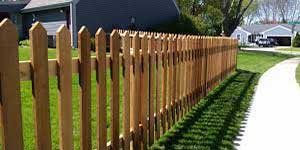
This is the most traditional design, featuring evenly spaced boards with pointed tops. The sharp tips deter climbing and give the fence a sharp, uniform look. Ideal for historic or colonial-style homes.
2. Dog-Ear Picket Fence
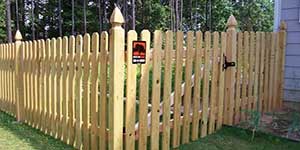
Instead of sharp points, each board is cut with a slight angle (like folded dog ears). This creates a softer, more casual appearance that works well in suburban neighborhoods.
3. Gothic Picket Fence
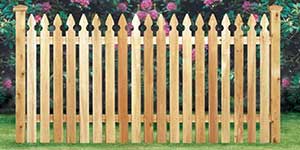
With its curved and pointed tops, the Gothic design adds elegance and a touch of old-world charm. It pairs beautifully with Victorian or ornate architectural styles.
4. Round-Top Picket Fence
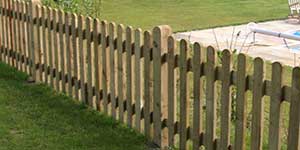
A playful, friendly version with rounded tops instead of sharp points. Great for homes with kids, since it’s safer and less likely to cause injury.
5. Square-Top Picket Fence
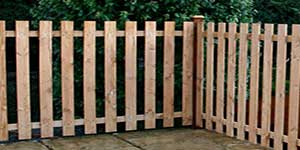
For homeowners who prefer clean, straight lines, the square-top style offers a modern twist on a traditional look. Perfect for contemporary homes or minimalist landscaping.
6. Scalloped Picket Fence
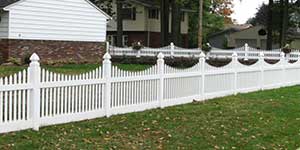
This design uses alternating heights to form a wave-like scalloped pattern. It adds visual interest and softens the rigid appearance of standard fences.
7. Arched Picket Fence
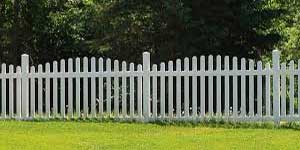
Similar to scalloped, but with a smooth arch across the top of the fence. It’s elegant and works well as a front yard focal point.
8. Shadowbox Picket Fence
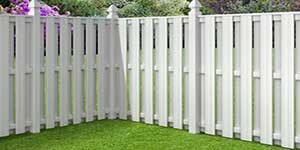
Boards are placed alternately on each side of the rails, creating a semi-private fence with depth. This design allows airflow while still offering some privacy.
9. Horizontal Picket Fence
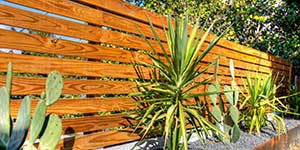
A modern adaptation that flips the orientation—pickets are laid horizontally instead of vertically. It’s sleek and trendy, often used in urban or modern home designs.
10. Custom Decorative Pickets
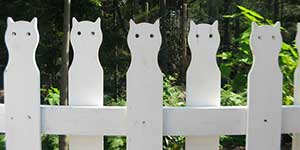
Some homeowners opt for cutouts, carved tops, or mixed materials (like combining wood with metal posts). This opens endless possibilities for a one-of-a-kind look.
Best Wood Types for Picket Fence Designs
The type of wood you choose for your fence affects not just appearance but also durability, maintenance, and cost. Here are the best options available in the United States:
1. Cedar
- Pros: Naturally resistant to rot and insects, lightweight, and visually appealing with reddish tones.
- Cons: Requires sealing or staining to maintain color and prevent weathering.
- Best for: Homeowners who want longevity with minimal maintenance.
2. Redwood
- Pros: Highly durable, naturally resistant to decay, beautiful rich color.
- Cons: More expensive than other woods.
- Best for: Premium fencing projects where aesthetics are the top priority.
3. Pressure-Treated Pine
- Pros: Affordable, widely available, and treated with preservatives to resist rot.
- Cons: Can warp or shrink over time, requires regular maintenance.
- Best for: Budget-friendly projects that still demand durability.
4. Cypress
- Pros: Naturally resistant to insects and decay, stable wood grain.
- Cons: Less available in some regions, can be pricey.
- Best for: Homeowners in humid or termite-prone areas.
5. Spruce
- Pros: Affordable, easy to work with, often used in prefabricated fence panels.
- Cons: Shorter lifespan compared to cedar or redwood.
- Best for: Temporary or decorative fences where budget matters most.
Best Exterior Paints and Stains for Picket Fences in the U.S. Market
Once you’ve chosen your design and wood type, protecting your investment with high-quality paint or stain is essential. Here are the best options available in the U.S. market:
1. Behr Premium Exterior Paint & Primer
- Excellent UV protection
- Long-lasting color retention
- Available in a wide variety of shades
2. Benjamin Moore Aura Exterior
- Self-priming formula with excellent coverage
- Resistant to mildew and fading
- Premium option with outstanding durability
3. Sherwin-Williams SuperPaint Exterior
- Affordable yet highly protective
- Excellent adhesion and weather resistance
- Popular among contractors and DIY homeowners
4. Valspar Duramax Exterior Paint
- Fade-resistant formula
- Great for extreme weather conditions
- Combines paint and primer in one
5. Cabot Solid Color Acrylic Deck & Siding Stain
- Ideal for wood fences where you want color with visible grain
- Provides excellent moisture resistance
- Long-lasting protection
6. Olympic Maximum Stain + Sealant
- Works as both a stain and water sealer
- Great for cedar and redwood fences
- Available in transparent, semi-transparent, and solid finishes
Choosing the Right Color for Your Fence
While the traditional choice for picket fences is white, modern homeowners are experimenting with various colors. Some trending options include:
- White: Timeless and classic.
- Gray: A modern, neutral alternative that works well with contemporary homes.
- Black: Bold and sophisticated, great for modern architecture.
- Natural Wood Tones: For those who want to highlight the beauty of cedar, redwood, or pine.
- Pastels: Light blue, soft yellow, or sage green for a playful, charming vibe.
Maintenance Tips for Picket Fence Designs
To keep your fence looking beautiful for decades:
- Clean regularly with mild soap and water.
- Inspect annually for loose boards, rot, or insect damage.
- Repaint or restain every 3–5 years depending on climate.
- Seal the wood to protect against moisture.
- Trim vegetation to prevent contact with damp plants or soil.
Cost Considerations for Picket Fences
The cost of a picket fence varies depending on materials, height, and design complexity. On average in the U.S.:
- Pressure-treated pine: $10–$20 per linear foot installed
- Cedar: $20–$30 per linear foot installed
- Redwood: $30–$50 per linear foot installed
Custom designs or premium paints will add to the price, but the long-term curb appeal and property value often outweigh the initial investment.
Why Picket Fence Designs Remain the Best Choice for Many Homeowners
Even with so many fencing options on the market—vinyl, aluminum, wrought iron—picket fences remain a favorite in the United States. They offer the perfect balance of affordability, customization, and timeless charm.
When paired with the right wood type and protective paint or stain, they can last for decades while continuing to elevate your home’s curb appeal. Whether you prefer the clean lines of a square-top fence or the elegance of a scalloped arch, there’s a design out there that fits your style and budget.
In short, picket fence designs aren’t just about boundaries—they’re about personality, tradition, and creating that welcoming first impression every homeowner desires.
Building the Perfect Picket Fence
If you’re considering a new fence, investing in a well-planned picket fence design is one of the smartest moves you can make for your property. Choose durable wood like cedar or redwood, protect it with a high-quality exterior paint or stain, and select a design that complements your home’s architecture.
With the right choices, your fence won’t just stand as a boundary—it will stand as a statement of style.